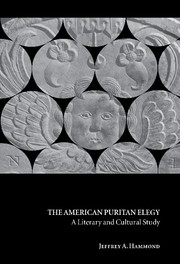Book contents
- Frontmatter
- Contents
- Preface
- Acknowledgments
- Introduction
- Chapter 1 Monuments enduring and otherwise
- Chapter 2 Toward an anthropology of Puritan reading
- Chapter 3 Weep for yourselves: the Puritan theology of mourning
- Chapter 4 This potent fence: the holy sin of grief
- Chapter 5 Lord, is it I?: Christic saints and apostolic mourners
- Chapter 6 Diffusing all by pattern: the reading of saintly lives
- Epilogue: Aestheticizing loss
- Notes
- Works cited
- Index
Introduction
Published online by Cambridge University Press: 22 September 2009
- Frontmatter
- Contents
- Preface
- Acknowledgments
- Introduction
- Chapter 1 Monuments enduring and otherwise
- Chapter 2 Toward an anthropology of Puritan reading
- Chapter 3 Weep for yourselves: the Puritan theology of mourning
- Chapter 4 This potent fence: the holy sin of grief
- Chapter 5 Lord, is it I?: Christic saints and apostolic mourners
- Chapter 6 Diffusing all by pattern: the reading of saintly lives
- Epilogue: Aestheticizing loss
- Notes
- Works cited
- Index
Summary
Stephen Greenblatt once justified his attraction to the past by confessing a “desire to speak to the dead” (Shakespearean Negotiations 1). If Greenblatt's motives appear morbid or nostalgic, mine will seem more so. In this book I have wished to speak to the dead about the dead, and in so doing to try making sense of a body of poems whose importance in their own time has been obscured by their nearly total neglect in ours. Although historians have traditionally justified their obsessions by claiming to explain the present or anticipate the future, the simple wish to connect with those who have gone before seems as valid and honest a reason as any for writing literary history. I do not deny that history can teach us something about ourselves by proposing the origins of current social and cultural practice and thereby shoring up – or perhaps debunking – our collective and individual place in the world. These high-sounding goals, however, nearly always mask something far more basic and even selfish in studying the past: the pleasure of hearing old stories and telling them back to life as fully and convincingly as we can. The historical impulse is, at root, a desire to tell stories about people who can no longer speak for themselves.
Like all history, this book tells a story about a story. The first story comprises what Puritans told each other about death and commemoration. The second story is my interpretive shaping of their story – my hearing of it.
- Type
- Chapter
- Information
- The American Puritan ElegyA Literary and Cultural Study, pp. 1 - 10Publisher: Cambridge University PressPrint publication year: 2000

